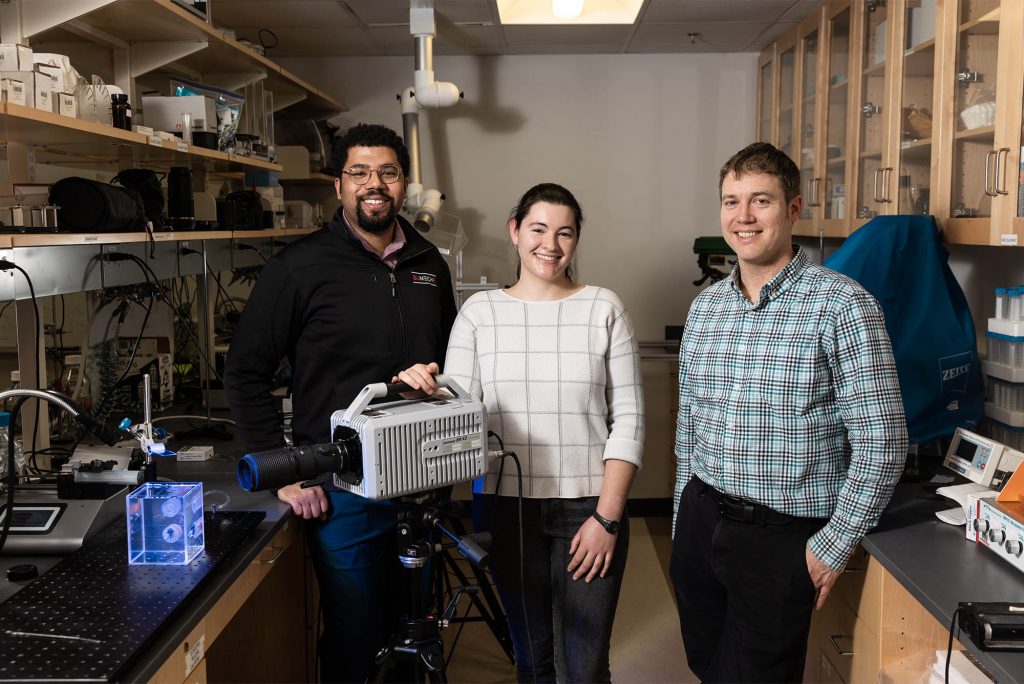New Bubble Popping Theory Could Help Track Ocean Pollution and Viruses
A bubble at the surface of a liquid bursts and creates three jet drops—BU researchers studied the first, or top, drop. Any particles trapped in that speedy drop are more likely to become highly concentrated. Courtesy of Dubitsky, McRae, and Bird
New Bubble Popping Theory Could Help Track Ocean Pollution and Viruses
BU engineers find why some particles—like microplastics—get concentrated and aerosolized by bursting bubbles, while others don’t
Bubbles are fun for everyone. But, it turns out, they can also be little menaces.
When a bubble pops, it can concentrate and aerosolize any particles stuck on it. Not a big deal when it’s a store-bought soapy bubble bursting in the yard or on your hand. But it’s a major concern when the particles it carries are potentially hazardous: bubbles caught in a crashing wave can send vaporized microplastics into the air where they might mess with the Earth’s atmosphere; bubbles burst by a flushing toilet can fling bacteria meters and onto nearby surfaces; a frothing cruise ship hot tub was once shown to be a Legionnaires’ disease super-spreader.
Now, a new study by Boston University engineers illustrates why bubbles fire some contaminants into the air, while allowing others to sink harmlessly. After taking a close-up look at what happens when bubbles pop, the researchers found a new way to predict which particles are flung high—and which ones fall—overhauling a 40-year-old theory of fluid dynamics. Their results, which were published in Physical Review Letters, could help scientists track marine pollution or more accurately predict a virus’ transmissibility.
“With this new theory, we can better model potential ocean sources of pollutants or how other particles in the ocean can get into the atmosphere and act as cloud condensation nuclei, altering the climate,” says Lena Dubitsky (ENG’23), a doctoral student in the BU Fluid Lab and joint lead author on the paper. “In terms of public health, this model helps predict what drop size might contain the most pathogens.” And that can be crucial in determining how easily a disease might spread or whether a small drop can sneak a virus through the defenses protecting our lower respiratory tract.
At their simplest, bubbles are a thin layer of liquid surrounding a gas. The bubbles kids love blowing, for example, are a layer of water trapped between two layers of soap molecules, with air in the middle. If you poke the bubble, it creates a hole, which quickly widens—the whole bubble pops in less than one-tenth of a second—forcing the outer soapy layer to collapse, packing its molecules together in a denser space. All of that movement and change in density—as well as the air inside flying up and out—propels drops of water and soap into the sky in a quick pop!

Doctoral student Lena Dubitsky (center) with her coauthors Oliver McRae (left), an ENG postdoctoral associate, and James Bird, an ENG associate professor of mechanical engineering. They used the high-speed camera to watch bubbles bursting in the small box at left. Photo by Jake Belcher
The retreat of that outer layer and the ejection of those drops—particularly the first, or top, drop to exit—is central to the BU Fluid Lab’s new theory. “We focus on jet drops in this study, which are created when the bubble cavity collapses and shoots up into a liquid jet, which pinches off into drops,” says Dubitsky. “In particular, we study the first jet drop since it tends to be the smallest and fastest, making it more likely to stay suspended in the atmosphere, to be transported the furthest, or be inhaled deeply into the respiratory tracts.” Any particles trapped in that first explosive drop are also more likely to become highly concentrated.
The BU researchers captured this footage of a millimeter-sized bubble at a liquid surface bursting and creating three jet drops—they were focused on the first, or top, drop. Courtesy of Dubitsky, McRae, and Bird
For the past four decades, researchers studying bubbles thought the all-important top drop was drawn from a uniform fluid layer surrounding the entire bubble—only particles small enough to sit in that layer would get pulled into it, meaning bigger particles would get left behind.
“We decided to use really big particles to stress test this old theory and found it didn’t apply at all,” says Dubitsky.
Instead, they discovered that the fluid forming the top drop doesn’t always surround the whole bubble, and that a bubble’s size and where a particle sits on it also determine what gets ejected and when. If that all seems a bit esoteric and technical, just think about SARS-CoV-2. For the past couple of years, our health has been inextricably tied to droplets—how they spread, what they carry with them, how long they linger in the air.
“In order to predict the infectivity of a particular pathogen, one needs to know the infectious dose, so when these droplets become ultraconcentrated, it really matters what size is becoming ultraconcentrated,” says Oliver McRae (CAS’12, ENG’20,’20), a joint lead author on the paper and BU College of Engineering postdoctoral associate. “If you have a 50-micron droplet [one micron is one one-thousandth of a millimeter], we don’t really care about that much. If you’re able to get larger particles and transport them much further than previously thought, that is a key takeaway.”

The small container was filled with liquid and microplastic particles. When a bubble bursts at the fluid’s surface, the top drop would hit the slide suspended above the box, allowing the team to analyze the particles taken along for the ride. Photo by Jake Belcher
To capture the bubbles in action, the research team set up a container filled with fluid and small microplastic particles—little pieces of polystyrene. They then blew bubbles of different sizes into the liquid, using high-speed cameras to watch them rise to the surface and burst. The top drop would splat onto a glass slide above the fluid’s surface, allowing researchers to analyze the particles left behind. McRae then created computer simulations of the bursting bubbles so they could dissect their speedy demise.
“What we saw is that as the bubble is collapsing and the fluid is being swept down toward the base, eventually becoming a jet, the fluid layer is getting thicker,” says McRae, “and so that compression allows for larger particles to get in.”
McRae’s simulation of a bubble bursting shows the expanding hole compressing the outer layer into a tighter space, before the top drop explodes up. Courtesy of Dubitsky, McRae, and Bird
With larger bubbles, the outer layer was pretty uniform to start with, completely surrounding the bubble; on smaller bubbles though, it barely covered the bottom half.
“That means if you’re a bacteria or a virus and you’re stuck on the upper half of the bubble, you’ll never get in the top drop in a small bubble,” says McRae. “That wasn’t taken into account or wasn’t predicted in previous theories.”
According to James Bird, an ENG associate professor of mechanical engineering and the Fluid Lab’s principal investigator, the research is exciting because it “opens up the possibility that there’s so much more going on than we had appreciated, than we even had the framework to appreciate.” As an example, he says, the Legionella bacteria, which causes Legionnaires’ disease and is transported by bursting bubbles, has an elongated rather than circular shape. What could his team’s latest findings mean for how it gets swept up in a bubble’s pop? And what could that mean for stemming outbreaks?
“Maybe in a toilet or swimming pool there are strategies one can take to make sure some of these places aren’t going to be as pathogenic,” says Bird. “Or maybe when you have something new, a novel virus or bacteria, there’s ways to predict, just based on the chemistry and the shape, how likely it is to be aerosolized. This work is a stepping stone.”
This study was supported by the National Science Foundation (NSF) and the NSF Graduate Research Fellowship Program.

Comments & Discussion
Boston University moderates comments to facilitate an informed, substantive, civil conversation. Abusive, profane, self-promotional, misleading, incoherent or off-topic comments will be rejected. Moderators are staffed during regular business hours (EST) and can only accept comments written in English. Statistics or facts must include a citation or a link to the citation.